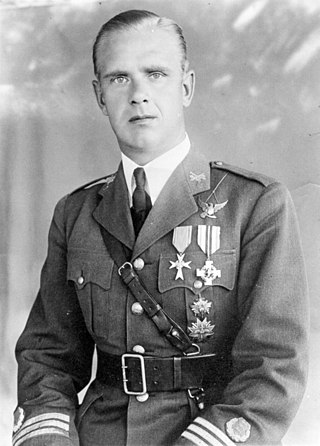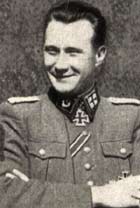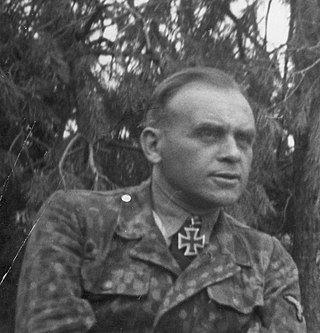
Alfons Vilhelm Robert Rebane was an Estonian military commander. He was the most highly decorated Estonian military officer during World War II, serving in various Wehrmacht and Waffen-SS units of Nazi Germany.

The Battle of Narva Bridgehead was the campaign that stalled the Soviet Estonian operation in the surroundings of the town of Narva for six months. It was the first phase of the Battle of Narva campaign fought at the Eastern Front during World War II, the second phase being the Battle of Tannenberg Line.

The Battle of Narva was a World War II military campaign, lasting from 2 February to 10 August 1944, in which the German Army Detachment "Narwa" and the Soviet Leningrad Front fought for possession of the strategically important Narva Isthmus.

The Battle of Tannenberg Line or the Battle of the Blue Hills was a military engagement between the German Army Detachment Narwa and the Soviet Leningrad Front. They fought for the strategically important Narva Isthmus from 25 July–10 August 1944. The battle was fought on the Eastern Front during World War II. The strategic aim of the Soviet Estonian Operation was to reoccupy Estonia as a favorable base for the invasions of Finland and East Prussia. Waffen-SS forces included 24 volunteer infantry battalions from the SS Division Nordland, the SS Division Langemarck, the SS Division Nederland, and the Walloon Legion. Roughly half of the infantry consisted of the personnel of the 20th Waffen Grenadier Division of the SS. The German force of 22,250 men held off 136,830 Soviet troops. As the Soviet forces were constantly reinforced, their overall casualties are estimated by Estonian historian Mart Laar to be 170,000 dead and wounded.

The 20th Waffen Grenadier Division of the SS was a foreign infantry division of the Waffen-SS that served alongside the Wehrmacht during World War II. According to some sources, the division was under Reichsführer-SS Heinrich Himmler's overall command but was not an integral part of the Schutzstaffel (SS). It was officially activated on 24 January 1944, and many of its soldiers had been members of the Estonian Legion and/or the 3rd Estonian SS Volunteer Brigade, which had been fighting as part of German forces since August 1942 and October 1943 respectively. Both of the preceding formations drew their personnel from German-occupied Estonia. Shortly after its official activation, widespread conscription within Estonia was announced by the German occupying authorities. The division was formed in Estonia around a cadre comprising the 3rd Estonian SS Volunteer Brigade, and was initially known as the 20th Estonian SS Volunteer Division. By 1944, a total of 60.000 Estonians were fighting in the ranks of the SS and Wehrmacht.

In the course of Operation Barbarossa, Nazi Germany invaded Estonia in July–December 1941, and occupied the country until 1944. Estonia had gained independence in 1918 from the then-warring German and Russian Empires. However, in the wake of the August 1939 Nazi-Soviet Pact, the Soviet Union had invaded and occupied Estonia in June 1940, and the country was formally annexed into the USSR in August 1940.

Harald Riipalu was an Estonian commander in the German Wehrmacht and the Waffen-SS during World War II. He was a recipient of the Knight's Cross of the Iron Cross of Nazi Germany.
The Tallinn offensive was a strategic offensive by the Red Army's 2nd Shock and 8th armies and the Baltic Fleet against the German Army Detachment Narwa and Estonian units in mainland Estonia on the Eastern Front of World War II on 17–26 September 1944. Its German counterpart was the abandonment of the Estonian territory in a retreat codenamed Operation Aster.

Harald Nugiseks was an Estonian serviceman in the Waffen-SS of Nazi Germany during World War II. A Waffen-Oberscharführer (sergeant), he served in the 20th Waffen Grenadier Division of the SS. Nugiseks was one of the four Estonians to receive the Knight's Cross of the Iron Cross.

Jürgen Wagner was a Brigadeführer in the Waffen-SS during World War II, the commander of the SS Division Nederland and was awarded the Knight's Cross of the Iron Cross with Oak Leaves.

Latvian Auxiliary Police was a paramilitary force created from Latvian volunteers and conscripts by the Nazi German authorities who occupied the country in June/July 1941. It was part of the Schutzmannschaft (Shuma), native police forces organized by the Germans in occupied territories and subordinated to the Order Police. Some units of the Latvian auxiliary police were involved in the Holocaust.
Estonian Auxiliary Police were Estonian police units that collaborated with the Nazis during World War II.

This is a sub-article to Leningrad–Novgorod Offensive and Battle of Narva.

This is a sub-article to Battle of Narva (1944).

The Narva offensive was an operation conducted by the Soviet Leningrad Front. It was aimed at the conquest of the Narva Isthmus from the German army detachment "Narwa". At the time of the operation, Joseph Stalin, the supreme commander of the Soviet Armed Forces, was personally interested in taking Estonia, viewing it as a precondition to forcing Finland out of the war.

This is a sub-article to Battle of Narva.

This is a sub-article to Battle of Narva (1944).
36th Estonian Police Battalion was an Estonian rear-security unit during World War II that operated under command of the German SS.
The 416th Infantry Division was a German infantry division of World War II.
Wartime collaboration occurred in every country occupied by Nazi Germany during the Second World War, including the Baltic states. The three Baltic republics of Estonia, Latvia and Lithuania, were occupied by the Soviet Union in the summer of 1940, and were later occupied by Germany in the summer of 1941 and then incorporated, together with parts of the Byelorussian Soviet Socialist Republic of the Soviet Union, into the Reichskommissariat Ostland. Collaborators with Germany participated in the Eastern Front against the Soviet Union, as well as in the Holocaust, both in and outside of the Baltic states. This collaboration was done through formal Waffen-SS divisions and police battalions, as well as through spontaneous acts during the opening of the war.











